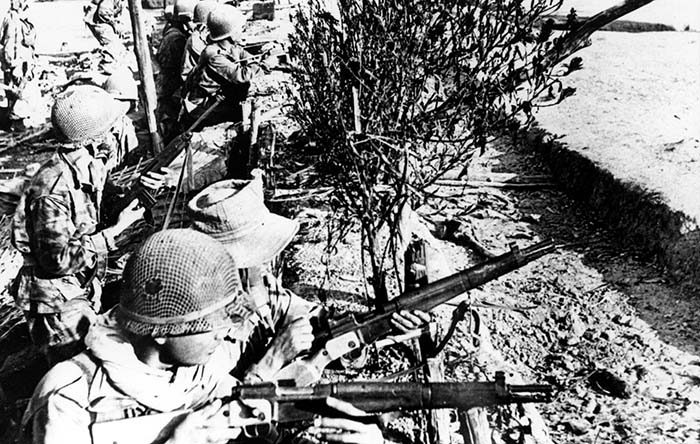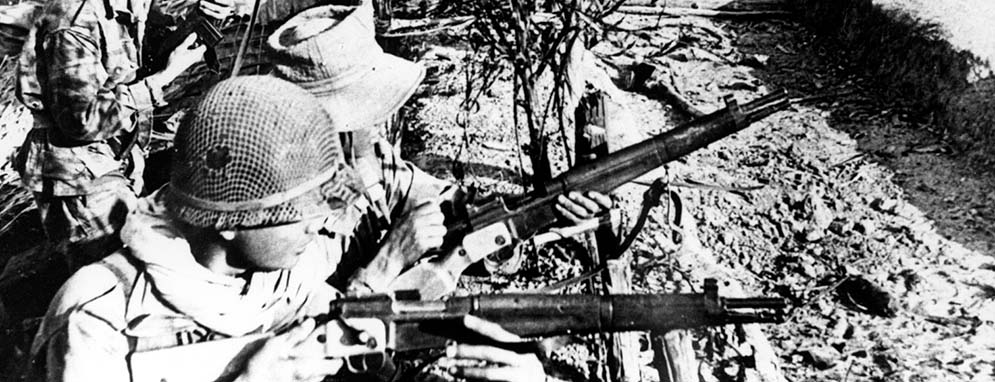By Robert Bruce
“French forces in Indochina were armed with a mixture of WWII British, American, French, and German weapons and equipment. Most of the British and American small arms, which constituted about 40 percent of those possessed by the French Army in Indochina, were worn-out or unserviceable due to a shortage of spare parts. A lack of suitable ammunition also limited the number of machine guns that could be kept in service.” From Advice and Support: The Early Years

Credit: US Army Military History Institute/Robert Bruce
At the end of WWII in 1945, exotic and resource-rich French Indochina, consisting of what is today Laos, Cambodia and Vietnam, had been under French control for more than a half century. Even the Japanese invaders had allowed a puppet French regime during the war. Despite diplomatic pressure from America and military threat from the growing communist/nationalist movement known as the Viet Minh, Paris was not about to let go of what was rightly considered to be the most valuable of its colonies. In one particularly dramatic incident in mid-November 1946, French naval, air and ground forces responded to escalating guerrilla attacks by bombarding the northern port city of Haiphong, killing an estimated 6,000 Vietnamese civilians.
Building on resentment caused by this and other incidents, in a radio broadcast on the 21st of December 1946, Ho Chi Minh called for nationwide resistance. The man whose name was to become synonymous with tenacious guerrilla warfare, told his countrymen that although the coming war would be long and hard, in the end “we are bound to win.”
Everything under the sun
Southeast Asia was awash in all sorts of small arms at the time, a legacy of years of Allied fighting against the Japanese. These were readily available for arming all sorts of tribal, ethnic and political factions and Ho lost no time in building up his forces.
According to contemporary estimates by the American OSS (Office of Strategic Services – direct predecessor to the CIA), the communist Viet Minh irregulars, scattered around the full length of Vietnam, numbered approximately 100,000 by early 1947. Additionally, Ho’s regular army under Vo Nguyen Giap consisted of more than 60,000 troops concentrated in what was then known as Tonkin – later North Vietnam.

Credit: US Army Military History Institute/Robert Bruce
“The Democratic Republic of Vietnam Army (Viet Minh) is supplied with an assortment of weapons and equipment of various makes and models. Virtually all materiel is from foreign sources, principally Communist China and the Soviet Union. Considerable materiel of French, British, Japanese and United States origin has also been acquired since WWII, initially from abandoned stocks and later by capture.” From U.S. Army Handbook for Vietnam, 1962
Substantial quantities of arms and ammunition were directly provided by China, Vietnam’s ancient northern border enemy that had formed a convenient alliance with fellow communist Ho Chi Minh. China also supplied large numbers of “advisors” to train Giap’s largely peasant forces and most of the Viet Minh regular and guerrilla units were led by native Vietnamese officers battle hardened in the war against Japan.
Land, Air and Sea
Although the French clearly had their hands full in trying to re-establish military and economic control over their reluctant subjects, the picture wasn’t all that bleak. By March of 1947 France had more than 90,000 fighters in Vietnam and 11,000 reinforcements were on their way. France enjoyed total air superiority and its naval forces were both strong and versatile. Understandably reluctant to build a native Indochinese military force that might one day turn against them, most were ethnic Frenchmen or colonial troops from Morocco, Senegal and other parts of the empire.
Also, the famous and colorful Legion Etranger (Foreign Legion) was in country, manning forts, spearheading numerous airborne operations, as well as reinforcing armored assaults and riverborne operations. With its ranks thickly populated by tough and combat-wise veterans of the defeated German Wehrmacht as well as those of many other European armies, La Legion maintained a well-deserved reputation for ferocity and skill at arms.
A Mixed Bag of Weapons
“…the table of equipment for a French battalion in Indochina provided for 624 rifles, 133 submachineguns, 41 BARs, 4 81mm mortars and 8 60mm mortars, while the corresponding battalion of the 304th Viet Minh Division counted 500 rifles, 200 submachine guns, 20 BARs, 4 81mm mortars, 3 recoilless cannon and 3 bazookas.” From Street Without Joy

Credit: US Army Military History Institute/Robert Bruce
Since France had been quickly overrun by the Germans in WWII, most of the small arms in the hands of regular and colonial troops were of pre-1941 French design and manufacture. It is likely that the reference to “BARs” quoted above for a French battalion is merely a generic term for automatic rifles/light machine guns. Although both sides made good use of actual American Browning Automatic Rifles which were readily available throughout Southeast Asia, the predominant weapon of this type in Indochina was the “Chatellerault” Model 1924/29. (For in-depth review of the 1924/29 see SAR Volume 4 Number 9)
“The 7.5mm Model 24/29 was a standard pre-World War II French Army weapon that was put back into production after the war. It is an excellent weapon of simple design and unsurpassed ease of maintenance. Although the French refer to this as an automatic rifle, it is a light machine gun by contemporary standards. Its double triggers, large wood forearm, and multiperforated conical flash hider are prime recognition features. There is a large vertical hole in the forearm; this is to adapt the gun to an antiaircraft or vehicular post mount.” From DIA Small Arms ID and Operation Guide

While American .30 and .50 cal. belt-fed Brownings were thoroughly integrated into France’s Indochina forces – mostly on armored vehicles and aircraft generously supplied by Uncle Sam – their standard machine gun was the 7.5mm M1931A. Basically a heavy-barrel upgrade of the Chatellerault designed for use in tanks and fortresses, the 31A is easily recognized by its lack of buttstock and forearm, plus side-mounted box mag or distinctive 150 round drum. Featuring gas operation and a lively cyclic rate of some 750 rpm, there was no provision for quickly changing overheated barrels. The 27.5 pound gun’s mixed reputation for serviceability and combat effectiveness apparently spurred development of the belt-fed AAT Mle 52.
Rifles were usually the simple and sturdy bolt action 7.5mm MAS 36 and folding-stock CR39 carbine, both easily identified by forward-swept operating handle and a prong bayonet stowed in reverse position so that its socket base looked like a second barrel. Additionally, limited quantities of the semiauto 7.5mm MAS 49 made it to Indochina where it proved serviceable, but combat experience influenced design modifications culminating in the MAS 49/56.
French-made submachineguns in use by her forces in Indochina included the very questionable MAS 38 and the superlative MAT 49. The MAS was a handy little machine pistol unfortunately chambered for the pipsqueak 7.65mm Model 1935 handgun cartridge, sometimes called .32 French Long. Quite controllable despite a 600 rpm rate of fire, its effectiveness was severely limited by underpowered ammunition.
On the other hand, the 9mm MAT 49 was a favorite of friend and foe alike because of its soldier-friendly design, excellent reliability and at least decently lethal parabellum cartridge. A compact, sturdy subgun of mostly stampings with machined barrel and bolt featuring simple blowback action, it was easy to shoot and easy to maintain. (See SAR Volume 5 Number 1 for an in depth review of the MAT 49)
Cleverly designed for compact carry with telescoping wire stock and fold-forward magazine housing, the MAT 49 was particularly suited for airborne and armored troop use. Its amenities include a grip safety to preclude accidental discharge when dropped and a spring-loaded firing port dust cover that automatically pops open on firing.
The Viet Minh, and later the Viet Cong, eagerly employed captured MAT 49s and many were subsequently found to have been converted to fire the more-plentiful stocks of communist 7.62 x 25mm pistol and burp gun ammo.
Mon Oncle Americaine
Up to his bearded chin in the Korean War which inconveniently broke out in 1950, Uncle Sam had a keen interest in keeping French Indochina from becoming yet another communist stronghold. To this end, literally millions of tons of American war materiel and hundreds of millions of American tax dollars were lavished on the French. Aircraft, ships, weapons, ammo, communications equipment, food, and countless other categories of aid poured in.

Credit: US Army Military History Institute/Robert Bruce
In addition to previously mentioned Browning machineguns, two categories of Yankee small arms were warmly embraced by France’s fighting men in Indochina. The little M1 carbine and its paratroop and select-fire variants were understandably popular with the small framed native troops who found their size, weight and light recoil to fit nicely. Inexplicably, standard-size Europeans of paratroop and other units seemed to be particularly fond of the carbine despite its poor lethality. Ah, the French…
On the other hand, the awesome American recoilless rifles and “bazooka” rocket launchers were clearly outstanding examples of American ingenuity that were particularly well suited for the war in Indochina. Essentially shoulder fired artillery, they provided heavy hit capability even to light infantry units operating in dense jungles. Vehicular convoys and remote outposts could also take advantage of these portable yet brutally effective high explosive stovepipes when facing concentrations of enemy troops.
Au Revois, Indochine
Despite highly effective weaponry from small arms to heavy howitzers, massive and continuing infusions of American aid including tanks and trucks of all kinds, fighter, bomber and transport aircraft providing undisputed mastery of the skies, France lost to peasant fighters of the Viet Minh. Following the disaster at Dien Bien Phu, demoralized French leaders agreed to hand over all of the territory north of Quang Tri above the 17th Parallel to Ho Chi Minh’s communists. In return, all of Giap’s troops in the south were supposed to pull out. Not only did they not leave as promised, they lavishly armed themselves with vast quantities of abandoned Franco-American war booty for the continuing struggle.
20 July 1954 marks both the end of France’s struggle to keep Vietnam in her dwindling empire and the beginning of what would ultimately become America’s longest war.
Primary References:
Advice and Support: The Early Years, US Army Center of Military History, 1983
US Army Area Handbook for Vietnam, 1962
Street Without Joy, Bernard Fall, Stackpole Co., 1964
Small Arms Identification and Operation Guide, Defense Intelligence Agency, 1976
| This article first appeared in Small Arms Review V5N8 (May 2002) |











